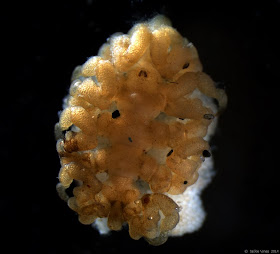This is Pycnogonum stearnsi, a common local sea spider often associated with sea anemones. Its legs are pulled in, and it's "hiding" a large mass of fertilized eggs — the white mass barely visible below the sea spider. Males have specialized legs (ovigers) for carrying the developing embryos. [For orientation, the anterior or head end (note the brown eyes) is pointing towards the top of the image.]
Viewed from below you can see the impressive number of embryos. And if you look very carefully, you should be able to see something else that's notable. Not all of the embryos are alike!
It may help if I zoom in. (And remember that you can click on the picture for a larger version.)
Can you see that there are two different masses of embryos, in different developmental stages? The uppermost embryos have reddish spots and are more mature...while the lowermost embryos are pure white, lack those spots, and are younger.
Here's an even closer view of the uppermost embryos (below). The reddish spots are eyespots.
Male sea spiders often gather different egg masses from multiple females. It's possible that the two egg masses are from the same female, but in a study done where they tested this (extensively), it was much more likely that different egg masses carried by one male were from different mates. (The egg masses could be from up to 4 different females, but more often they were from 1-3 females.)
The males will carry the embryos for 1-2 months until the larvae hatch.
Facts above from: Barreto, F.S. and J.C. Avise. 2010. Quantitative measures of sexual selection reveal no evidence for sex-role reversal in a sea spider with prolonged paternal
care. Proc. R. Soc. B 277: 2951-2956.




No comments:
Post a Comment